Sidamo Coffee Features Huakui 6.0 Coffee Bean Flavor taste and name Source latest News
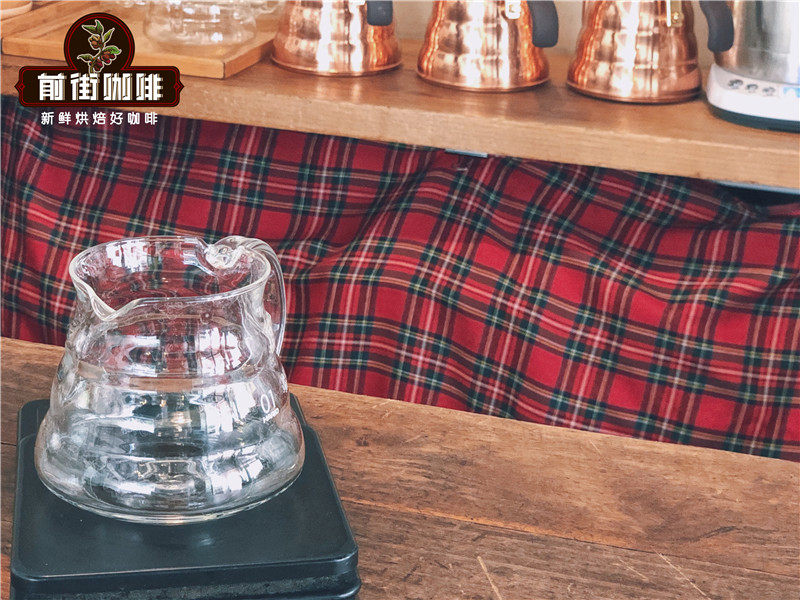
For professional baristas, please follow the coffee workshop (Wechat official account cafe_style)
Speaking of Sidamo, I have to say that there is a coffee bean called "Sakuran". From 17 years to now, Sakuran has been deeply loved by everyone.
Guji producing area
The Guji producing area, which once belonged to the Sidamo producing area, has been independent into a new producing area by the Ethiopian Commodity Exchange (ECX) in 2010. The Guji producing area, located in the southeast of Yejasuffi, is an area with complex topographical changes such as towering mountains, valleys and plains. The geology of this area belongs to the nutrient-rich black soil (Vertisol), the depth of the soil is nearly two meters, and the average elevation is more than 1800 meters. The significant temperature difference between day and night created by geographical characteristics makes the local area have various local conditions for producing high-quality coffee.
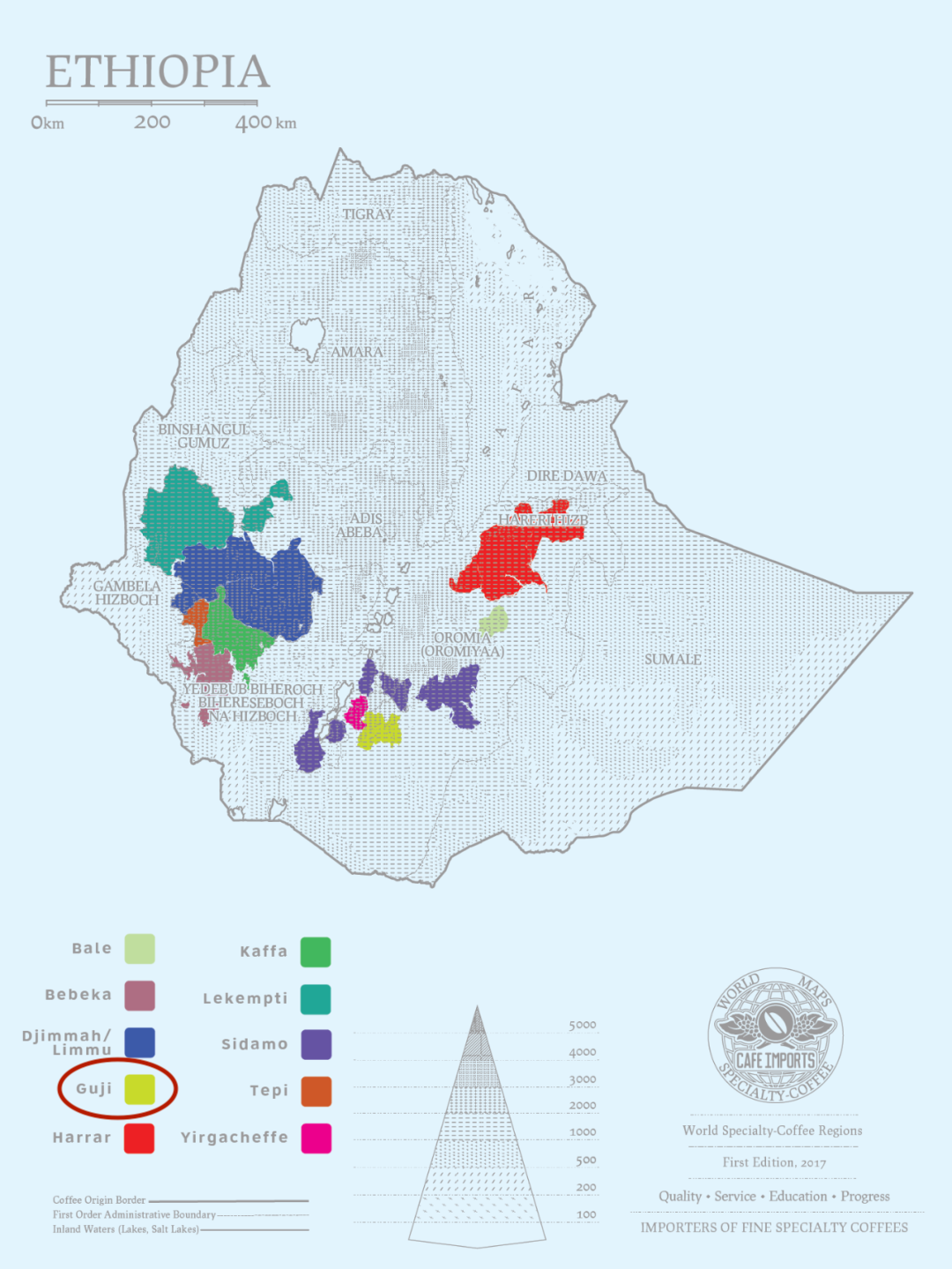

Gujizi producing area-- Humbera Hambella
The west of Humbera Hambella is across the mountain from Kochore, and the east and south are connected with other sub-areas of Shakiso, Uraga and Kercha in Guji. At present, there are about 20 processing plants of various sizes in Humbera production area.
In the Humbera Mountains, villagers live in mountains 2000 meters above sea level, with no roads and no electricity, and government-supported faucets are the only source of drinking water for the whole village. Although the villagers have to be huddled in the same thatched hut with their livestock, the air here is free and happy. Local children will ride a little donkey to the village to fetch water. They are always cheering and shyly exchanging corn and avocados from nowhere for candy from the world outside the mountains. In the sun field, the curry farmers who turn the red fruit of coffee always sing cheerful songs barefoot and smile. It is precisely under the hand selection of these simple villagers that everyone's favorite Huakui coffee beans have come into the cup.
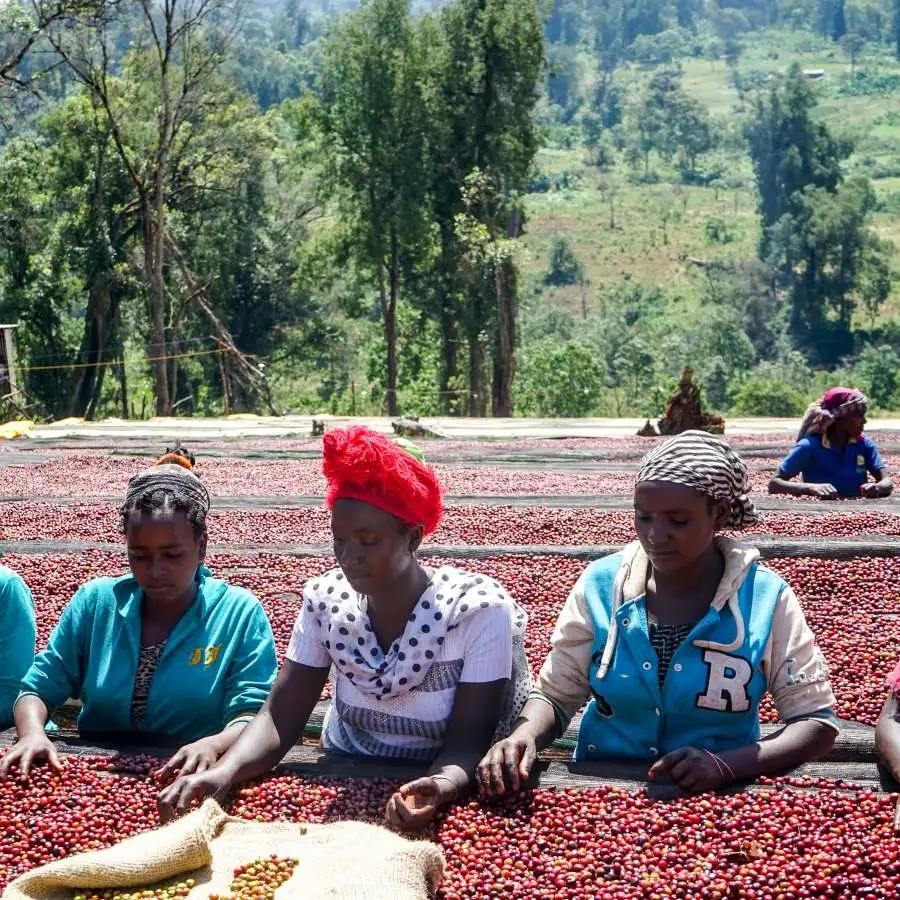
In 2017, a sun bean from DW's "Buku Abel" processing plant won the TOH championship, and Chinese raw bean importers named the bean Sakuran, which at that time had a strong strawberry and creamy aroma. Later, DW increased the number of manor processing plants in Humbera Hambella's core production area, Dimtu, to four, namely "Buku Abel", "Buku Saysay", "Haro Soresa" and "Tirtiro Goye", with an annual output of about 1100 tons of coffee.
In all these estates and processing plants, strictly speaking, only sun-cured coffee from the "Buku Abel" processing plant is called "Sakuran Coffee beans", which is why Sakui 2.0, Sakui 3.0 and Sakui 3.1 appeared in 2018 and 2019, respectively.
First of all, where did the name "Sakuran" come from?
If you observe carefully, the Chinese and English names of the coffee bean "Huakui" will not match. It is called "Huakui" in Chinese, and it is more likely to be "Hambella" in English, which is literally translated as "Humbela". In 2017, Ethiopia's DW Raw Bean Company sent their coffee beans to the TOH (the Taste Of Harvest) Raw Bean Competition hosted by the African Coffee Association, and a sun batch from the "Buku Abel" processing plant won the TOH Ethiopia championship with its strong strawberry and cream aroma. At that time, this batch of raw beans was introduced by raw bean traders in Beijing. Because of the identity of the champion, they were given the name of "Sakuran".
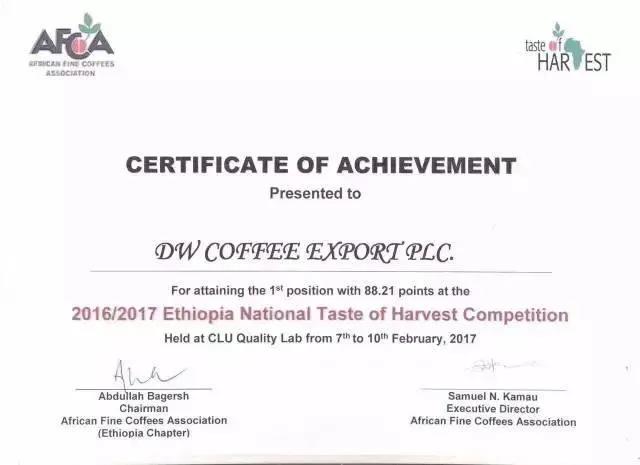
In the same year, Li Jianfei from Beijing won the runner-up of the 2017 World Coffee Brewing Competition in China with this coffee, pushing the popularity of Sakuran again, because most of the players chose coffee beans in rosy summer, while Sakuran, a native species from Ethiopia, defeated many rosy summers that year. Won the second place of that year (although the second place can not be won only by the quality of Sakuran, but the good quality of Sakuran is also one of the factors to achieve a good ranking), so it is not difficult to imagine that this Sakuran is comparable to Rosa Coffee.
Sun treatment of Huakui coffee beans
In the annual coffee harvest and treatment season (December-January), coffee picked by farmers must have a sugar content of more than 30 before they can start sun treatment. In the first two days of the sun, it is necessary to ensure the humidity of the coffee red fruit, so that its fructose is fully fermented. At the same time, the geographical location of the high altitude makes the temperature of the treatment plant drop to about 12 degrees Celsius at night, without excessive fermentation because of the high temperature. When the temperature is relatively high at noon, it will be shielded in time to prevent sunburn of coffee red fruit. In order to prevent sudden rain at night, it will be wrapped in thick plastic sheeting.
In this way, the red coffee fruit is fermented and dehydrated at a lower temperature. After 18 days of sun treatment, the moisture content of raw coffee beans decreased to about 13%, stopped the sun treatment, put it in sacks, put it into the warehouse under the natural conditions of 12-22 degrees Celsius and 45-55% humidity, and raised raw beans and further dehydration for about 50 days. When the moisture content of raw beans reaches about 11%, it is transported to the treatment plant for shelling and screening.
Introduction of Huakui Coffee beans from Qianjie Coffee
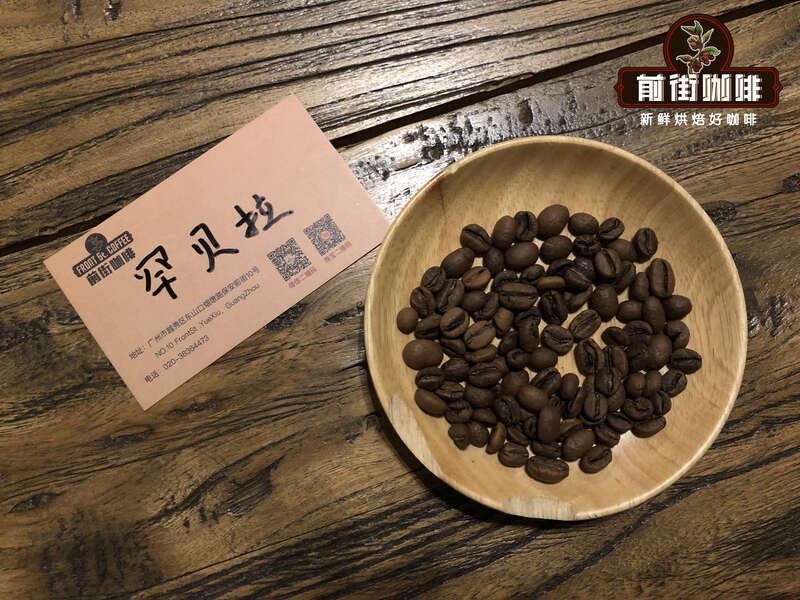
Qianjie Coffee-Saizhuakui G1
Producing area: Gujinhambela
Processing plant: Buku Able
Altitude: 2250-2350 m
Variety: native species
Grade: G1
Treatment: insolation
Flavor: strawberry, passion fruit, berry, pineapple, cream, nut
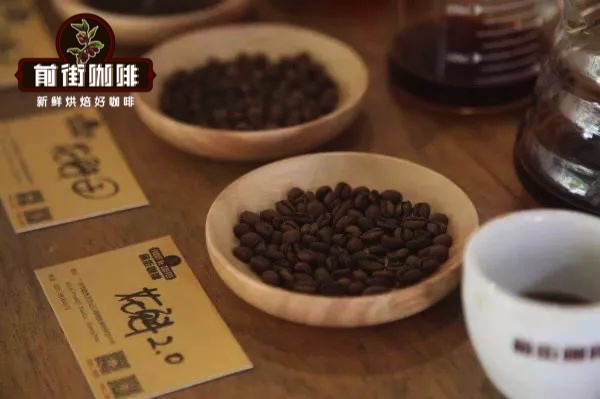
Qianjie Coffee-Ethiopia Sakuran 2.0
Producing area: Gujinhambela
Processing plant: Goro processing plant
Altitude: 2316 m
Variety: native species
Grade: G1
Treatment: insolation
Flavor: floral, tropical fruit, red wine, nuts
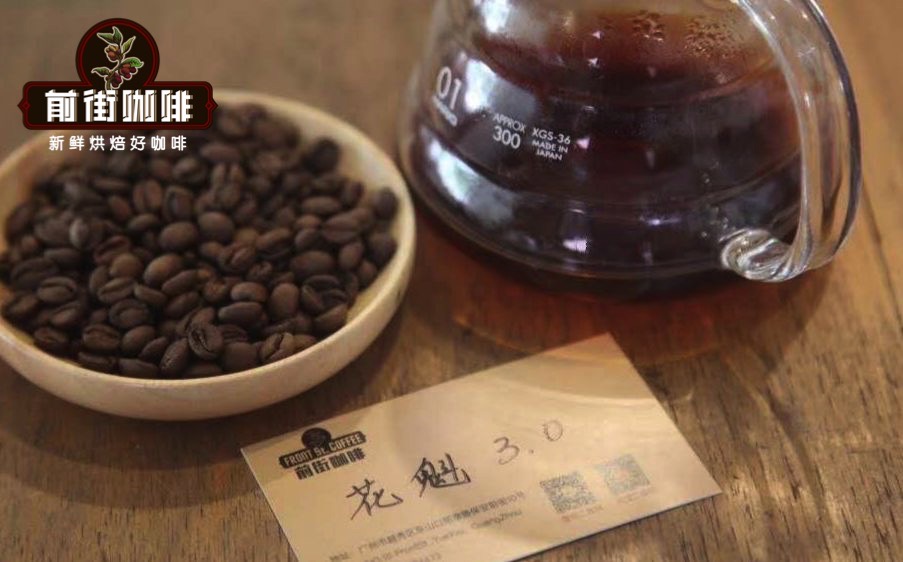
Qianjie Coffee-Ethiopia Sakuran 3.0
Producing area: Gujinhambela
Processing plant: Goro processing plant
Altitude: 2300 m
Variety: native species
Grade: G1
Treatment: solarization
Flavor: floral aroma, berry, mango, pineapple, apricot
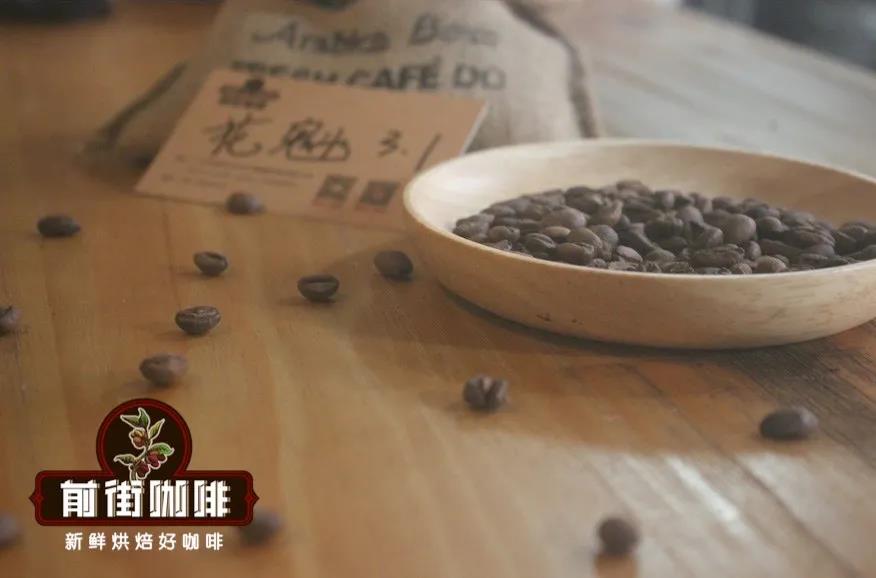
Qianjie Coffee-Ethiopia Sakuran 3.1
Producing area: Gujinhambela
Treatment plant: Mansa Shantang treatment plant
Altitude: 2125 m
Variety: MANSA native species
Grade: G1
Treatment: insolation
Flavor: tropical fruit, citrus, caramel, cream
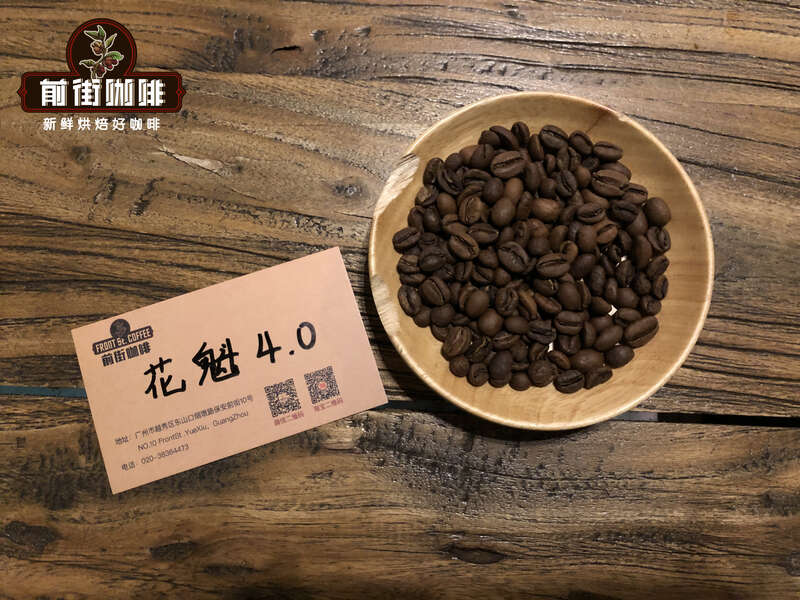
Qianjie Coffee-Ethiopia Sakuran 4.0
Producing area: Gujinhambela
Processing plant: Buku Able
Altitude: 2350 m
Variety: Dega
Treatment: insolation
Batch: new batch in 2020
Flavor: rose, cream strawberry, citrus, passion fruit, oolong tea
Qianjie Coffee purchase this batch of Sakuran 4.0, compared to Sakui 3.0 bean type is smaller, this is because of the different varieties. Sakui 3.0 is a coffee bean native to Ethiopia, while Sakui 4.0 is a Dega variety.
What is the Dega variety?
This year, Ethiopia held the Cup of Excellence Cup for the first time ("CoE" for short), in which the top 28 coffee varieties were classified in unexpected detail. Dega, ranked 21, has two very different versions of its name. In one version, it is said that Dejia's name comes from a kind of sparkling wood, and the aroma of Dejia when baking is very similar to the burning aroma of this sparkling wood. Another version explains that Dejia "dega" is the Ethiopian root for "highlands and shady places", while Dejia often grows up at high altitudes. It is a pity that Dejia was not among the top 14 in this COE competition, so he did not collect the relevant flavor description. And this time Qianjie Coffee Sakuran 4.0 is the Dega variety of coffee beans.
Baking record of 5 Huakui coffee beans in Qianjie Coffee
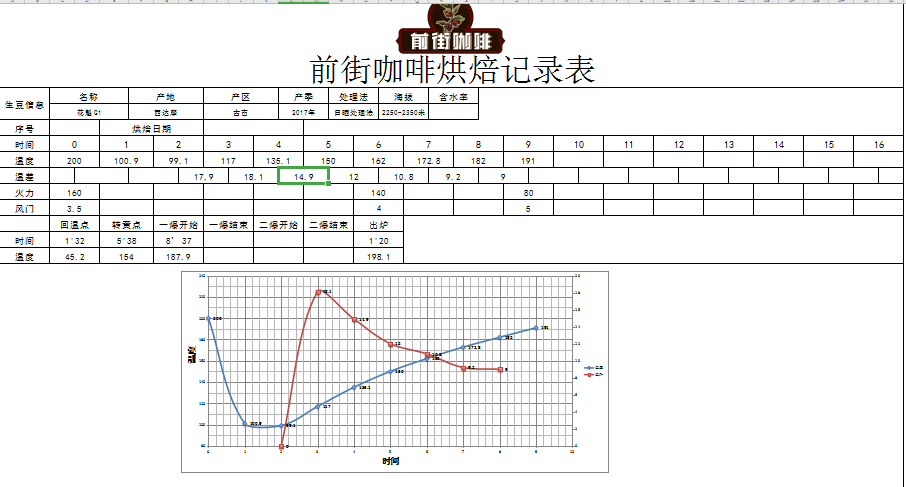
Qianjie Coffee Huakui G1 baking curve: Yangjia 800N, bean dosage 480g: furnace temperature to 160 degrees Celsius into the pot, throttle 3.5, firepower 160, temperature recovery point 1 "39" 32 "; 5: 38" when the temperature is 154 °C, the bean table turns yellow, the smell of grass disappears completely, and the dehydration is complete. When the bean surface appears ugly wrinkles and black markings, the smell of toast obviously changes to the smell of coffee, which can be defined as a prelude to an explosion, it is necessary to listen carefully to the sound of an explosion point, when the sound of an explosion point begins to explode, the throttle is fully open, the firepower of 191oC is reduced to 80 degrees, the throttle is opened fully, and the development time of an explosion is 1x20 ", and put in the pot at 198.1 degrees.
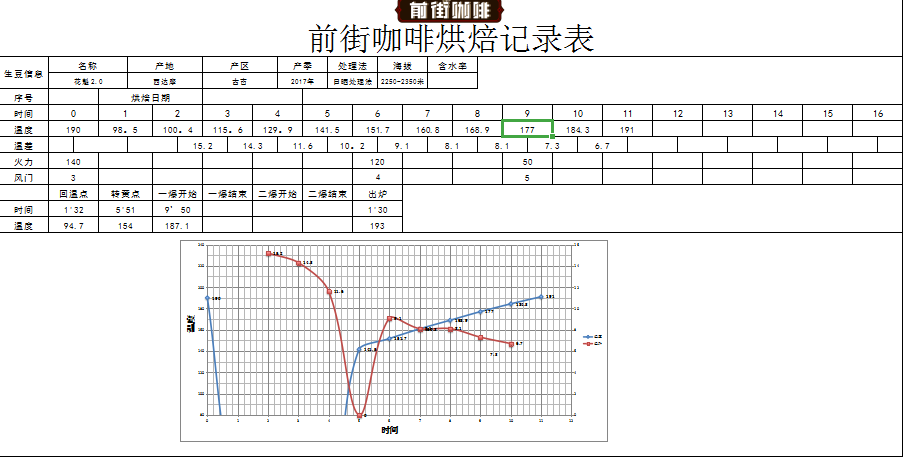
Qianjie Coffee Huakui 2.0 baking curve: Yangjia 800N, bean dosage 480g: stove temperature to 190 degrees Celsius into the pot, throttle open 3, firepower 140, temperature recovery point 1 "yellow" when the temperature is 154 °C, the smell of grass disappears completely and dehydration is completed. Furnace temperature 152 °C when the firepower dropped to 120, throttle opened 4, when the bean surface ugly Hu wrinkles and black markings, the smell of toast obviously changed to coffee, can be defined as a prelude to explosion, this time to listen carefully to the sound of an explosion point, to 9: 50 "the sound of an explosion, the throttle is fully open, 177 degrees firepower is reduced to 50, the throttle is opened 5, an explosion development time 1: 30", put the pot at 193 degrees.
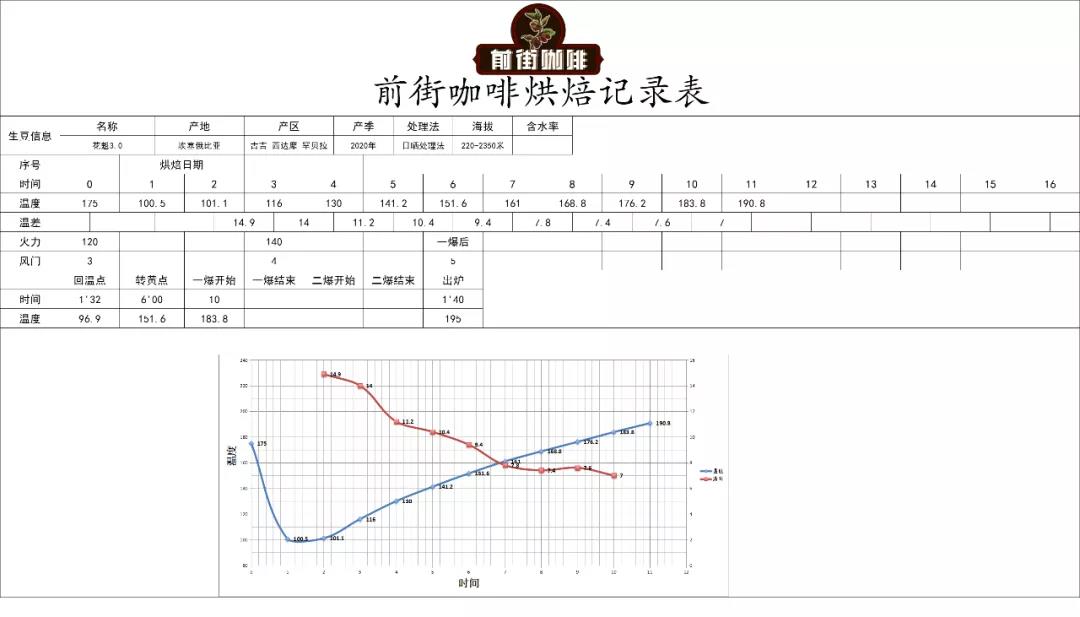
Qianjie Coffee Huakui 3.0 baking curve: Yangjia 800N, bean dosage 480g: stove temperature to 175 degrees Celsius into the pot, throttle open 3, firepower 120, temperature recovery point 1 "yellow" when the temperature 152 °C, the smell of grass disappears completely, dehydration is completed. When the furnace temperature is 116 °C, the firepower rises to 140, the throttle opens 4, when the bean surface appears ugly wrinkles and black markings, the smell of toast obviously changes to the smell of coffee, which can be defined as a prelude to an explosion, it is necessary to listen carefully to the sound of an explosion point. To 10: 00 "start to explode, the throttle is fully open, and the development time of the explosion is 1: 40", put into the pot at 195 degrees.
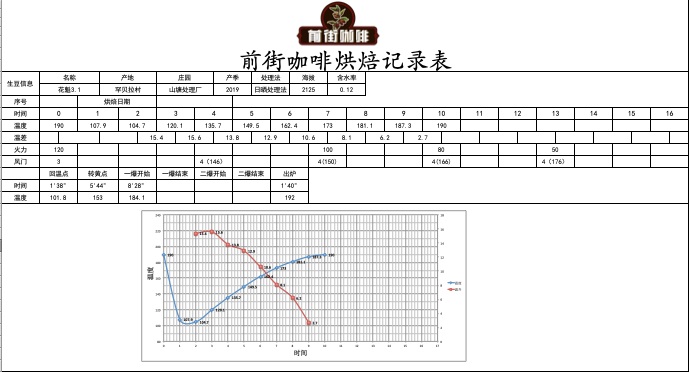
Qianjie Coffee Huakui 3.1 baking curve: Yangjia 800N, bean dosage 480g: furnace temperature to 190 degrees Celsius into the pot, throttle open 3, firepower 120, temperature recovery point 1 "yellow" when the temperature is 153 °C, the bean table turns yellow, the smell of grass disappears completely, and the dehydration is completed. When the temperature of the furnace rises to 1146, the throttle opens 4, when the bean surface appears ugly wrinkles and black markings, the smell of toast obviously changes to the smell of coffee, which can be defined as a prelude to explosion, this time to listen carefully to the sound of an explosion point, the sound of an explosion point begins to explode, the throttle is fully open, the firepower of 173degrees is reduced to 50 degrees, the throttle remains unchanged, the development time of an explosion is 1: 40 ", and put into the pot at 192 degrees.
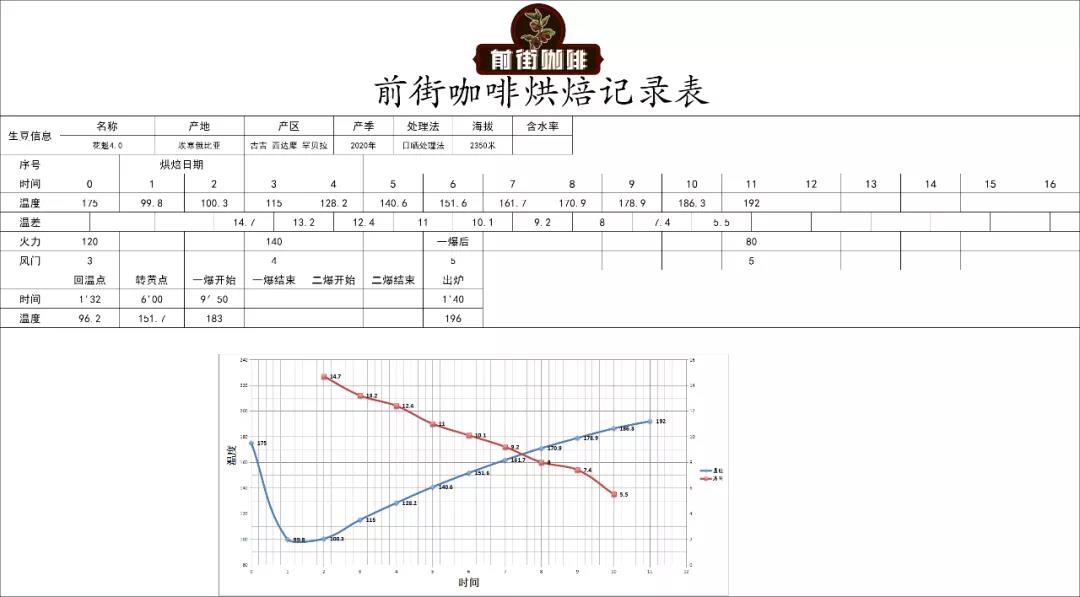
Qianjie Coffee Huakui 4.0 baking curve: Yang 800N, bean dosage 480g: furnace temperature to 175 degrees Celsius into the pot, throttle 3, firepower 120. Rise to 140 degrees, throttle open 4. Bake to 6: 00 ", the temperature is 151.7 degrees, the bean surface turns yellow, the smell of grass disappears completely, and the dehydration is completed. When the bean surface appears ugly Hu wrinkles and black markings, the smell of toast obviously changes to the smell of coffee, which can be defined as a prelude to an explosion. At this time, it is necessary to listen carefully to the sound of the explosion point, which starts to explode at 9: 50 ", the throttle is fully open, and the firepower of 188 degrees is reduced to 80." the development time of an explosion is 1: 40 ", put into the pot at 196 degrees.
Qianjie Coffee brewing parameters & techniques
In order to fully extract the rich layering of Huakui coffee beans, Qianjie uses higher water temperature and finer grinding degree for extraction, but in order to avoid over-extraction caused by high temperature, faster filter cups such as V60 filter cups will be used. The V60 filter cup is in a 60 °cone shape, and the tapered angle allows the coffee powder to be distributed centrally, and when water is injected, the water can automatically converge to the center of the filter cup to ensure that the contact time between the water and the coffee powder is sufficient, so that the appropriate coffee liquid can be extracted. In addition, the ribs on the inside of the body of the V60 filter cup extend clockwise from the bottom to the top, so that there is enough space between the filter paper and the filter cup, so that the flow of water is good. Coupled with the large holes in the bottom, the flow velocity is relatively faster than that of many filter cups.

Filter cup: V60 # 01
Water temperature: 90-91 degrees
Powder content: 15g
Ratio of powder to water: 1:15
Degree of grinding: BG6m/ fine sugar size (20 sieve bowl sieve powder to 80%)
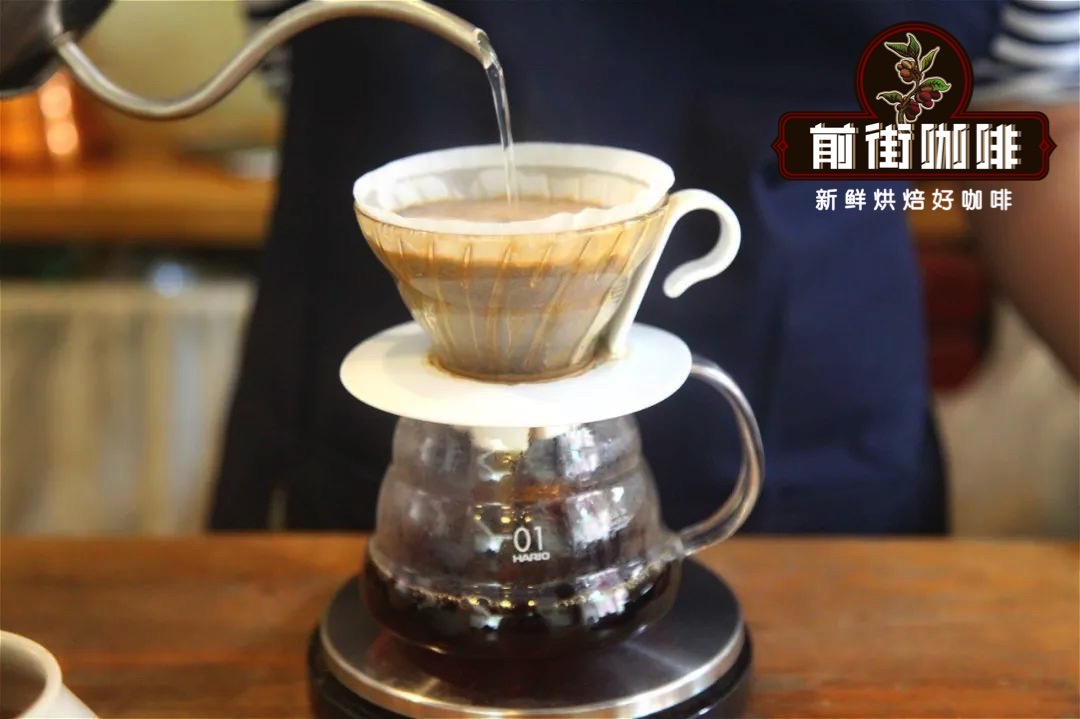
Qianjie cooking technique: the first section is filled with 30 grams of water for 30 seconds, followed by 95 grams (the electronic scale shows about 125 grams), and the injection is completed in about 1 minute. When the water level drops to 2 grams in the powder layer, the remaining 100 grams are injected at 3 places (about 225 grams on the electronic scale), about 1 minute 40-1 kilogram 39 percent 45 "seconds. 2: 00"-2 percent 39 percent 10 "trickling is completed, remove the filter cup and complete the extraction.
Description of cooking flavor
[Sakui G1] smooth, passion fruit, fermented wine, jackfruit, strawberry.
[Sakuran 2.0] the overall taste is clean, berry aromas will be more obvious, and with nutty aromas, the taste will be richer.
[Huakui 3.0] light strawberry jam, black tea, sweet aftertaste.
[Sakui 3.1] Flower, cream, tropical fruit, caramel, sweet and lasting.
[Huakui 4.0] citrus acid, berry juice fullness, lemon black tea, long-lasting sweetness.
Judging from the flavor performance of the above brewing, Qianjie believes that it is not just Sakui, but basically the taste of most coffee fluctuates every year. Why?
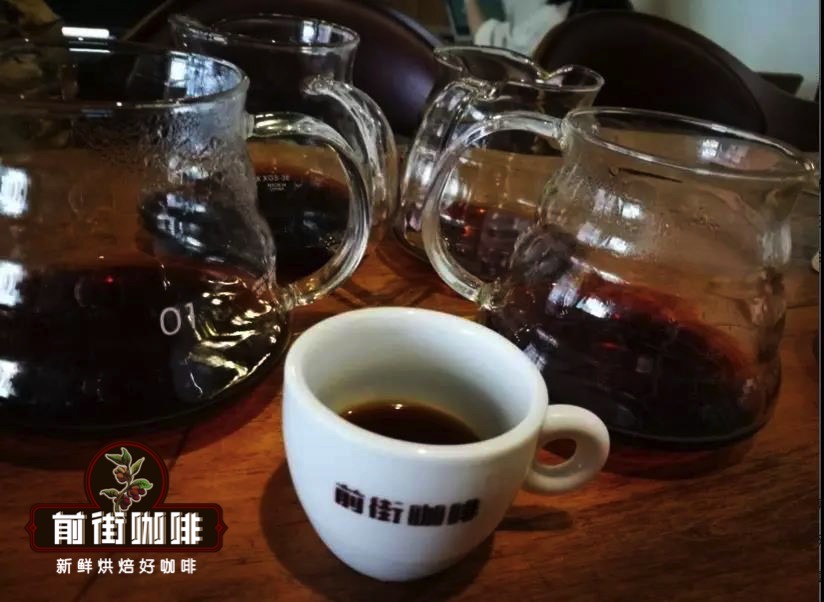
In addition, picking and selection are also factors that make batches different from year to year. If you look closely, you will find that 17-year-old Sakui coffee beans are of different sizes (the characteristics of Ethiopian coffee beans are due to the fact that the coffee grading system is based on defects. Second, there are many native varieties), the second year, the size of the Sakui 2.0 coffee beans becomes the same, and now the Sakui 4.0 beans are smaller than the Sakui 3.0 beans. But the difference from previous years can also be found from the appearance of coffee beans. When the time comes this year, the change of Sakuran is not satisfied with this. This year, you can even see washed Sakuran coffee beans and black honey-treated Sakuran coffee beans, and the name of Sakui has become more diverse.
For more boutique coffee beans, please add private Qianjie coffee on Wechat. WeChat account: kaixinguoguo0925
Important Notice :
前街咖啡 FrontStreet Coffee has moved to new addredd:
FrontStreet Coffee Address: 315,Donghua East Road,GuangZhou
Tel:020 38364473
- Prev

Introduction to the taste and flavor characteristics of Sidamo Huakui coffee varieties
For the exchange of professional baristas, please follow the coffee workshop (Wechat official account cafe_style) Hambella is located in GUJI, the largest coffee producing area in Ethiopia, and the administration is subordinate to the state of Oromia. West of Hambella and kochor of Yega Xuefei
- Next

How much is Sidamo Sakuran coffee price
Professional baristas please pay attention to the coffee workshop (Wechat official account cafe_style). In order to prevent sudden rain at night, it will be wrapped in thick plastic sheeting. In this way, the red fruit is fermented and dehydrated at a lower temperature. After 18 days of sun treatment, the moisture content of raw coffee beans is reduced to about 13%. Stop the sun treatment and put it in a sack at 12-22 degrees Celsius and 40-50% humidity.
Related
- Detailed explanation of Jadeite planting Land in Panamanian Jadeite Manor introduction to the grading system of Jadeite competitive bidding, Red bid, Green bid and Rose Summer
- Story of Coffee planting in Brenka region of Costa Rica Stonehenge Manor anaerobic heavy honey treatment of flavor mouth
- What's on the barrel of Blue Mountain Coffee beans?
- Can American coffee also pull flowers? How to use hot American style to pull out a good-looking pattern?
- Can you make a cold extract with coffee beans? What is the right proportion for cold-extracted coffee formula?
- Indonesian PWN Gold Mandrine Coffee Origin Features Flavor How to Chong? Mandolin coffee is American.
- A brief introduction to the flavor characteristics of Brazilian yellow bourbon coffee beans
- What is the effect of different water quality on the flavor of cold-extracted coffee? What kind of water is best for brewing coffee?
- Why do you think of Rose Summer whenever you mention Panamanian coffee?
- Introduction to the characteristics of authentic blue mountain coffee bean producing areas? What is the CIB Coffee Authority in Jamaica?

